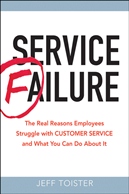Banish "black box" decision making
 Jeff Toister
Jeff Toister  Friday, April 10, 2009 at 1:46PM |
Friday, April 10, 2009 at 1:46PM | There's a lot of definitions for "black box". My definition is a decision-making process that's widely used in many companies today:
Black Box Decision Making: Sequester yourself and your team in a conference room, shut the doors, shut the windows, forget the facts, hide the data, cut the phone line, disable the internet, and turnoff all cell phones. Stay in the moment and ignore your objectives. Better yet, don't waste time setting any objectives at all, just react. Agendas, action plans, project charters, sponsor sign-offs, and the like are also equally useless and should be disregarded, minimized, or avoided completely.
Do not invite customers, vendors, other departments, or anyone else who may have insight into the discussion. Avoid sampling, analysis, or piloting at all costs. Be sure to use words like "I think", "I believe", "I heard", and "I hope" when making a point or proposing a course of action. Try to forget what happened the last time you faced a similar decision or what was decided when you had the same meeting to discuss the same issue last week.
Be sure to write two emails once a black box decision is made. The first email graciously accepts all the credit for an outstanding decision. The second email places the blame for a series of egregious errors on colleagues, counterparts, or co-workers. Save both emails as "drafts" until someone higher up tells you whether they like or dislike the outcome of your black box decision. Send the appropriate email along with a meeting request to start the whole process all over again.
Banishing Black Box Decision Making. Companies that want true performance avoid black box decision making like the plaque. They start by clarifying what they want and then carefully plan a course of action to get there. Jim Womack recently wrote an article for the Lean Enterprise Institute that stressed the need to clarify your purpose before making major changes. You can also check out this great case study on Inc. where a trio of entrepreneurs receive feedback on their marketing plan for a new energy drink and then used their clear vision to decide which advice to follow. Toister Performance Solutions even offers a duo of assessments to help you improve organizational performance by setting clear targets and establishing an action plan to get there.



